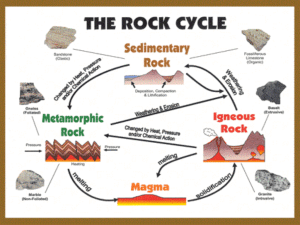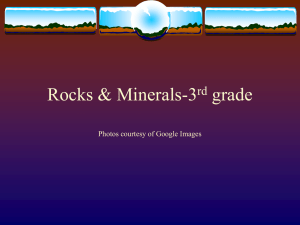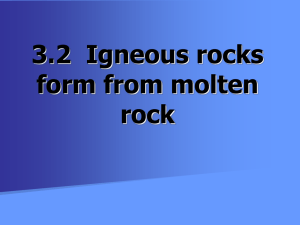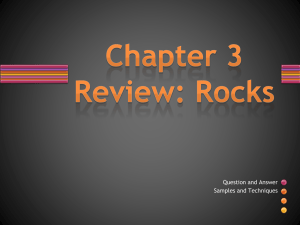ROCK
advertisement
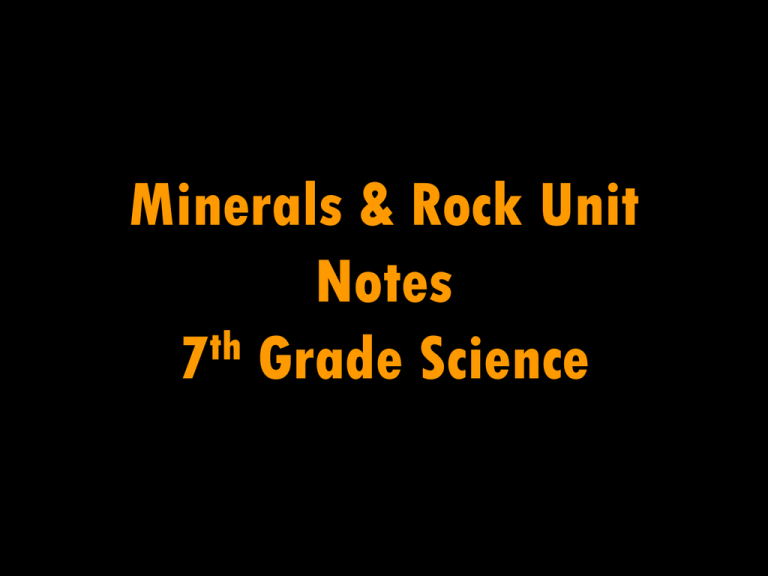
Minerals & Rock Unit Notes th 7 Grade Science Rocks • Are divided into 3 groups based on how they were formed •Sedimentary •Metamorphic •Igneous • Are made of one or more minerals • Do not stay the same • Continually changed by processes such as Weathering, Erosion Compaction, Cementation, Melting, and Cooling. • Rocks can change to and from the 3 types The Rock Cycle EARTH MATERIALS CHANGE BACK AND FORTH AMONG THE DIFFERENT TYPES OF ROCKS. Igneous (Granite #11) Melting, Solidification Recrystallization Melting, Solidification Sedimentary (Sandstone #6) Recrystallization Metamorphic Weathering, Erosion, Deposition, Compaction, Cementation (Gneiss #14) Processes that form Sedimentary Rock • Weathering: the breaking down of the Earth’s material by natural processes (Water, Wind, Ice, Chemicals, etc.) into smaller pieces or sediments • Erosion: weathered rock and soil particles are moved from place to place • Deposition: weathered sediments are laid down in a new location creating new landforms or rocks • Compaction: heavy sediments press down on the layers beneath • Cementation: dissolved minerals flow between the sediments and cement them together Processes that form Igneous & Metamorphic Rock • Melting: caused by heat and pressure around the rock to form magma • Solidification: magma cools and hardens • Recrystallization: while cooling, rock can develop crystals, depending on conditions Complete the following: •Turn in your Rock Cycle Directed Reading & Earthquake/Volcano Test Corrections •Get the 2 Directed Readings from the table •Have something to write with •Clear off your table Complete the following: •Turn in your Rock Cycle Directed Reading, Comic Strip & Earthquake/Volcano Test Corrections •Get the Igneous Rock Directed Reading from the table •Get out your Minerals & Rocks Notes •Have something to write with •Clear off your table Igneous • Igneous is Latin for “born of fire” • Formed from cooling magma or lava •Forms when magma cools and solidifies •Some reaches the surface of earth before cooling, other cools under the surface Intrusive (Example: Granite) Extrusive • Form below ground from magma • Usually has coarse crystals (grains) from cooling slowly • Some have large and small crystals • Form above ground from lava (Examples: Pumice & • Usually have small or no crystals Obsidian) from cooling quickly Into the Bedrock intrusive (crystals) On top (Exit) extrusive (no crystals) Bedrock Magma! Complete the following: •Get out your Minerals & Rocks Notes •Get the Paper from the table •Have a Textbook •Have something to write with But then the EARTH’S elements Will not leave the ROCK alone! •Ice •Wind •Water ice wind water THEY BREAK UP THE STONE DEPOSIT & COMPRESS THE SEDIMENTS One way Sedimentary Rock can be formed That ROCK changed again! Sedimentary Rock • Formed from sediments (rock fragments, mineral grains, animal and plant remains) that are pressed or cemented together or when sediments precipitates out of a solution. • Sediments are moved by wind, water, ice, or gravity. • Water or wind breaks down (Weathering), moves (Erosion), and deposits sediment (Deposition) • The heavy sediments press down on the layers beneath (Compaction) • Dissolved minerals flow between the sediments and cement them together (Cementation) Sedimentary Rocks & Fossils • • Deposited sedimentary rocks form horizontal layers called STRATA. • Process of arranging sedimentary rocks into layers is STRATIFICATION • Scientist know that the layers and fossils on top are YOUNGER than the fossils in lower layers LAW OF SUPERPOSITION Types of Sedimentary Rocks • Clastic: made of broken pieces of other rocks. • Organic: remains of once living plants and animals are deposited in thick layers called fossils • Chemical: minerals dissolved in lakes, seas, or underground water • Limestone made when calcite precipitates from sea water • Rock salt made from evaporation of sea waters The Rock Cycle Igneous Metamorphic Sedimentary ? The Rock Cycle Igneous Metamorphic kinda melted Sedimentary squished Bands (CAN) Form Metamorphic means “changed” Metamorphic Rocks • Rocks changed due to intense heat and high pressure • “Meta-” means “changed” and “-morphosis” means “shape” in Greek • Igneous, Sedimentary and other Metamorphic rocks can change to become Metamorphic rocks How Metamorphic m Rocks Change • Pressure from overlying rock layers • High heat, but not enough to melt the rock • Rocks may be flattened or bent or atoms may be exchanged to form new materials. • Think of metamorphic rocks as a squished peanut butter and jelly sandwich in your lunch. Types of Metamorphic Rock • Has visible parallel layers or Foliated bands you can see • Example: Gneiss formed from rearrangement of minerals in Granite into bands Non-Foliated • Not layered & no bands are formed • Example: Marble formed from Limestone The Rock Cycle Igneous metamorphic Sedimentary The Rock Cycle always changing… Youngest Rocks Here ! Oldest Rocks Here !



